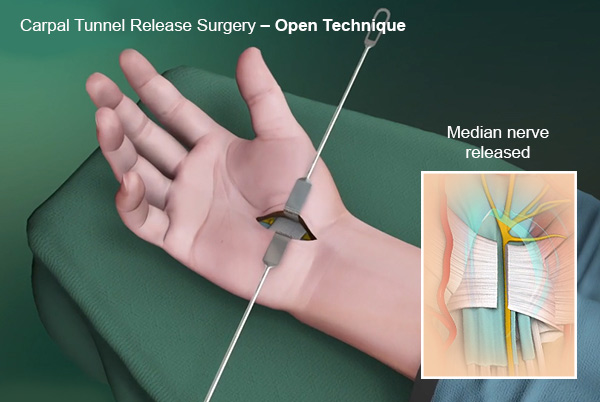Median Nerve (Carpal tunnel release surgery)
The carpal tunnel is a narrow passageway on the palm side of your wrist. Small wrist bones known as carpals form the bottom and sides of your carpal tunnel and a strong band of connecting tissue, known as the transverse carpal ligament, covers the top of the carpal tunnel.
The carpel tunnel houses the flexor tendons, that allow you to bend your fingers, and the median nerve that provides sensation to most of your fingers and hand.
Special tissues known as synovium surround and lubricate the flexor tendons in your wrist, allowing smooth movement of the fingers. Carpal Tunnel Syndrome occurs when the synovium swells narrowing the limited space within the tunnel and pinches the median nerve over time. The transverse carpal ligament can also become tight narrowing the carpal tunnel space and putting pressure on the median nerve.
Signs & Symptoms
Some of the common symptoms associated with Carpal Tunnel Syndrome include
- Numbness and tingling in the thumb, index, and middle fingers
- Pain and burning in the hand and wrist that may radiate up the arm to the elbow
- Decreased sensation and weakness in the hand with diminished grip strength
- Worsening of symptoms at night
Causes
The following factors have been known to increase a person’s risk of developing carpal tunnel syndrome:
- Repetitive Motion: performing heavy, repetitive hand and wrist movements with prolonged gripping at work or play
- Congenital: Some people are born with narrower carpal tunnel canals.
- Trauma: Injury to the wrist such as fractures or sprains.
- Hormonal Changes: Pregnancy, menopause, birth control pills or hormone pills are risk factors as they alter the levels of hormone in the body.
- Medical Conditions: Conditions such as hypothyroidism, rheumatoid arthritis, diabetes, obesity, gout, overactive pituitary gland, or the presence of a cyst or tumour extending to the carpal tunnel
Diagnosis
Your doctor diagnoses carpel tunnel syndrome by performing a detailed medical history and physical examination. Further tests may be ordered including an X-ray to view your wrist bones; blood tests to rule out underlying medical conditions such as diabetes, arthritis and thyroid problems, and electro diagnostic testing to assess the speed and degree of electrical activity in your nerves and muscles.
Treatment
Carpel tunnel syndrome can be treated with conservative measures or surgical intervention. When conservative treatment options are not effective, surgery may be recommended.
Surgical Procedure
Open Carpal Tunnel Release Surgery is performed in the operating room as an outpatient procedure.

You will be given a local anesthetic to numb your hand and wrist. Your surgeon makes a 2-inch incision at the base of the palm. Retractors are used to hold the skin edges apart in order to allow better visualization and exposure of the underlying tissues. A special cutting instrument is introduced through the incision and the transverse carpal ligament is transected under direct vision. This widens the carpal tunnel and releases pressure from the median nerve. The wound is washed out and the operative incision is closed with sutures and covered with a sterile dressing.
Risks and Complications
Some of the potential complications of carpal tunnel release surgery include
- Infection
- Damage to nerves causing weakness, paralysis, or loss of feeling in the hand and wrist area
- Stiffness to the wrist and hand
- Wrist weakness and loss of strength due to injured tendon









